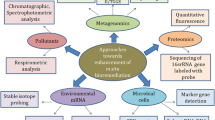Abstract
This work aimed at evaluating the biodegradability of different bacterial surfactants in liquid medium and in soil microcosms. The biodegradability of biosurfactants by pure and mixed bacterial cultures was evaluated through CO2 evolution. Three bacterial strains, Acinetobacter baumanni LBBMA ES11, Acinetobacter haemolyticus LBBMA 53 and Pseudomonas sp. LBBMA 101B, used the biosurfactants produced by Bacillus sp. LBBMA 111A (mixed lipopeptide), Bacillus subtilis LBBMA 155 (lipopeptide), Flavobacterium sp. LBBMA 168 (mixture of flavolipids), Dietzia Maris LBBMA 191(glycolipid) and Arthrobacter oxydans LBBMA 201(lipopeptide) as carbon sources in minimal medium. The synthetic surfactant sodium dodecyl sulfate (SDS) was also mineralized by these microorganisms, but at a lower rate. CO2 emitted by a mixed bacterial culture in soil microcosms with biosurfactants was higher than in the microcosm containing SDS. Biosurfactant mineralization in soil was confirmed by the increase in surface tension of the soil aqueous extracts after incubation with the mixed bacterial culture. It can be concluded that, in terms of biodegradability and environmental security, these compounds are more suitable for applications in remediation technologies in comparison to synthetic surfactants. However, more information is needed on structure of biosurfactants, their interaction with soil and contaminants and scale up and cost for biosurfactant production.
Similar content being viewed by others
References
Berna JL, Cassant G, Hager C-D, Rehman N, López I, Schowanek D, Steber J, Taeger K, Wind T (2007) Anaerobic biodegradation of surfactants—scientific review. Tenside Surf Det 44:312–347
Bodour AA, Miller-Maier RM (1998) Application of a modified drop-collapse technique for surfactant quantitation and screening of biosurfactant-producing microorganisms. J Microbiol Methods 32:273–280
Cooper DG, Zajic JE, Gerson DF (1979) Production of surface-active lipids by Corynebacterium lepus. Appl Environ Microbiol 37:4–10
Dennis RM, Dworkin D, Lowe WL, Zukpo AJ (1992) Evaluation of commercially available soil-washing processes for site remediation. J Hazard Ind Was 24:515–525
Desai JD, Banat IM (1997) Microbial production of surfactants and their commercial potential. Microbiol Mol Biol Rev 61:47–64
Frank N, Lissner A, Winkelmann M, Hüttl R, Mertens FO, Kaschabek SR, Schlömann M (2010) Degradation of selected (bio-)surfactants by bacterial cultures monitored by calorimetric methods. Biodegradation 21:179–191
Franzetti A, Di Gennaro P, Bevilacqua A, Papacchini M, Bestetti G (2006) Environmental features of two commercial surfactants widely used in soil remediation. Chemosphere 62:1474–1480
Garcia MT, Campos E, Dalmau M, Illán P, Sánchez-Leal J (2006) Inhibition of biogas production by alkyl benzene sulfonates (LAS) in a screening test for anaerobic biodegradability. Biodegradation 17:39–46
Hendershot WH, Lalande H, Duquette M (1993) Soil sampling and methods of analysis. Lewis Publishers, Boca Raton
Horowitz S, Gilbert JN, Grilfin WM (1990) Isolation and characterization of a surfactant produced by Bacillus licheniformis 86. J Ind Microbiol Biotechnol 6:243–248
Li J-L, Bai R (2005) Effect of a commercial alcohol ethoxylate surfactant (C11–15E7) on biodegradation of phenanthrene in a saline water medium by Neptunomonas naphthovorans. Biodegradation 16:57–65
Li J-L, Chen B-H (2009) Surfactant-mediated biodegradation of polycyclic aromatic Hydrocarbons. Materials 2:76–94
Lin S-C, Chen Y-C, Lin YM (1998) General approach for the development of high-performance liquid chromatography methods for biosurfactant analysis and purification. J Chromat A 825:149–159
Margesin R, Schinner F (1997) Laboratory bioremediation experiments with soil from a diesel-oil contaminated site—significant role of cold adapted microorganisms and fertilizers. J Chem Biotechnol 70:92–98
Mohan PK, Nakhla G, Yanful EK (2006) Biokinetics of biodegradation of surfactants under aerobic, anoxic and anaerobic conditions. Water Res 40:533–540
Mulligan CN, Yong RN, Gibbs BF (2001) Heavy metal removal from sediments by biosurfactants. J Hazard Mater 85:111–125
Nitschke M, Pastore GM (2002) Biossurfactantes: propriedades e aplicações. Quim Nova 25:772–776
Rosen MJ (2004) Surfactants and interface phenomena, 3rd edn. Wiley, New Jersey
Schleheck D (2003) Biodegradation of synthetic surfactants: linear alkylbenzenesulfonates (LAS) and related compounds. Dissertation, University of Konstanz, Germany
Singh KL, Kumar A, Kumar A (1998) Short communication: Bacillus cereus capable of degrading SDS shows growth with a variety of detergents. World J Microbiol Biotechnol 14:777–779
Singh A, Van Hamme JD, Ward OP (2007) Surfactants in microbiology and biotechnology: part 2. application aspects. Biotechnol Adv 25:99–121
Soil Survey Staff (1999) Soil taxonomy: a basic system of soil classification for making and interpreting soil surveys. Agriculture Handbook 436, 2nd edn. Natural Resources Conservation Service, United States Department of Agriculture, Washington, DC
Tiehm A (1994) Degradation of polycyclic aromatic hydrocarbons in the presence of synthetic surfactants. Appl Environ Microbiol 60:258–263
Van Ginkel CG (1996) Complete degradation of xenobiotic surfactants by consortia of aerobic microorganisms. Biodegradation 7:151–164
Vater J, Kablitz B, Wilde C, Franke P, Mehta N, Cameotra SS (2002) Matrix-assisted laser desortion ionization-time of flight mass spectrometry of lipopeptide biosurfactants in whole cells and culture filtrates of Bacillus subtilis C-1 isolated from petroleum sludge. Appl Environ Microbiol 68:6210–6219
Yeomans JC, Bremner JM (1988) A rapid and precise method for routine determination of organic carbon in soil. Comm Soil Sci Plant Anal 19:1467–1476
Acknowledgments
The authors would like to acknowledge the financial support granted by the FINEP/CTPetro, and the Brazilian National Research Council (CNPq) for the scholarship to one of the authors.
Author information
Authors and Affiliations
Corresponding author
Rights and permissions
About this article
Cite this article
Lima, T.M.S., Procópio, L.C., Brandão, F.D. et al. Biodegradability of bacterial surfactants. Biodegradation 22, 585–592 (2011). https://doi.org/10.1007/s10532-010-9431-3
Received:
Accepted:
Published:
Issue Date:
DOI: https://doi.org/10.1007/s10532-010-9431-3




